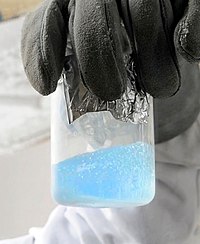
Photo from wikipedia
We study the room-temperature (RT) pulsed cathodoluminescence (PCL) spectra of a set of pure synthetic (both crystalline and amorphous) silicon dioxide samples. We show that the PCL spectra of all… Click to show full abstract
We study the room-temperature (RT) pulsed cathodoluminescence (PCL) spectra of a set of pure synthetic (both crystalline and amorphous) silicon dioxide samples. We show that the PCL spectra of all samples (both amorphous and crystalline) possess bands with intensity maxima in the region of 487 – 500 nm (2.54 – 2.48 eV). These bands are the most intense in the PCL spectra of disordered materials. We investigate the annealing behavior of RT PCL spectra of the crystalline and amorphous samples. Annealing has no significant effect on this emission. We demonstrate that the surface area of the material plays no role in the emission of PCL bands at 415 and 490 nm in the spectra of α-quartz single crystal and crystalline powder with grain sizes of 10 – 100 μm. Our results show that the bands in the region of 2.5 eV are the universal property of all synthetic pure SiO2 samples. The nature of the SiO2 emission band in the region of 2.5 eV is not clear; we discuss two possible explanations. The first one is based on considering the intrinsic emission due to self-trapped exciton (STE) decay with the transient O-O (oxygen–oxygen) bond formation. The second one is based on the role of Li ions in the emission process.
Journal Title: Journal of Russian Laser Research
Year Published: 2018
Link to full text (if available)
Share on Social Media: Sign Up to like & get
recommendations!